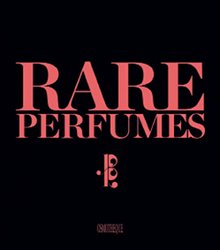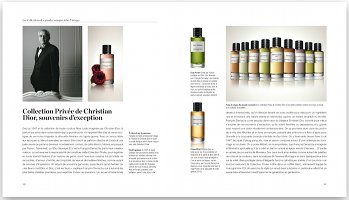
Rare Perfumes (the French version is called Parfums Rares) is a celebration of niche perfumery, in a coffee table format with large illustrations and plenty of white space (see images below). It was commissioned by the Osmothèque, the museum and scent archive in Versailles, and sponsored by The Fragrance Foundation France, InterParfums, Robert Piguet and Parfums de Nicolaï, among others. It was written by two fragrance journalists, Sabine Chabbert and Laurence Férat, and features a preface by Patricia de Nicolaï.
If you're looking for a critical, in-depth analysis of how niche perfumes fit into — or don't fit into — the larger fragrance market, or how niche influences mainstream or vice versa, look elsewhere (and tell me where you find it). This is not that, nor is it a niche version of something like Michael Edwards' Perfume Legends: French feminine fragrances, with its focus on perfume development and the interplay between brands, perfumers, marketers and designers. Other than in passing, you will learn relatively little about individual fragrances or how they differ from from their mainstream counterparts, nor (again, other than in passing) will you learn which niche fragrances are considered standard bearers or classics, or which perfumes are the "must smells" from each house.1

Rather, the focus here is on brands, and the main quibble I have with the book is that it reads, at times, like an extended product brochure or advertisement. We learn that the "subtle style fully expresses the perfumer's delicate femininity with flawless taste" (Annick Goutal), that "the spirit of the pioneers, abounding in creativity, still soars" (Diptyque) and that "because he knows that women can't resist such things, he offers them clutches, some plain and others extravagant, so that they can try to hide their secrets" (By Kilian). If you want to know which brands are most important, or which have made a lasting impact on perfumery, or which, perhaps, are no longer quite so soaring in creativity as they once were, again, you'll have to look elsewhere, as each house is presented in the same adulatory tone used by mainstream fashion magazines.

The book is organized in five chapters, and by brand within each of the first four chapters. "The Pioneers" covers Annick Goutal, L'Artisan Parfumeur, Comme des Garçons, Creed, Diptyque, Maître Parfumeur et Gantier, Parfums de Nicolaï and Serge Lutens. "The New Wave" covers younger brands like Atelier Cologne, Frédéric Malle, Etat Libre d'Orange, By Kilian, Le Labo, Maison Martin Margiela — really? half the fun of books like this is complaining about who is and isn't included, but Maison Martin Margiela? — Mark Buxton, Memo, Olfactive Studio, Parfumerie Générale, Parfum d'Empire and The Different Company. Each brand in these first two sections is covered in two to four pages, with large illustrations throughout.
"From Elsewhere" looks at "foreign brands", that is, brands that aren't based in France. Here we have Bond no. 9, Floris, Humiecki & Graef, Les Nez, Penhaligon's, Santa Maria Novella, and then four quick pages that cover smaller Italian brands (Lorenzo Villoresi, Carthusia, etc) in very short sections.

"Special collections & vintage fragrances" considers exclusive collections from mainstream brands, and perfume houses that have reintroduced collections of vintage classics. Included are Armani Privé, Selection Caron, Cartier Heures de Parfum, Les Exclusifs de Chanel, Dior La Collection Privée, Fragonard, Guerlain's exclusive collections, the Hermessences, Jean Patou, Parfums d'Orsay, Robert Piguet, the Prada Exclusives, Tom Ford Private Blend and Van Cleef & Arpels Collection Extraordinaire.
"Labels & Distribution", the last chapter, is a bit of a mishmash, but it's mostly about the Paris stores where you might buy these fragrances: Le Bon Marché, Printemps Paris, Colette, Jovoy and Nose. There are also a few pages on the niche distributor Différentes Latitudes. Many of the smaller niche brands that did not rate their own pages are mentioned, albeit quickly, in this chapter.
At the back of the book, there are quick lists that might be helpful to the reader: more niche and brand stores, perfume blogs, a short list of other perfume books, fragrance trade shows. Finally, there are two pages on the Osmothèque and the work they are doing to preserve the world's great perfumes.
Do you need this book? Well, I can say unequivocally that I would have loved to have had a copy when I was just starting out and couldn't keep all the niche brands straight, much less remember which brand made what or how the brand got its start. For a newbie interested in niche, it would be a great thing to have. If you love coffee table books about perfume and have little in your library covering niche (and there aren't that many books on the subject, although do see also Cult Perfumes: The World’s Most Exclusive Perfumeries by Tessa Williams), it's obviously worth buying, and the price, €39, is not bad at all in comparison to what some perfume books cost.
For a more experienced perfumista, or for anyone just as comfortable finding information online as on the printed page, it's perhaps not so necessary. It's not a book that I'm likely to turn to again and again as a reference, and unlike the last perfume book I reviewed, 22 Perfumers: a creative process, it doesn't have much material that you couldn't as easily discover online by visiting the respective brand's websites.
Chabbert, Sabine and Laurence Férat
Rare Perfumes / Parfums Rares
152 pages with 300 photographs
Osmothèque / Éditions Terrebleue, 2014
The book is due for publication in March. It can be mail-ordered directly from the Osmothèque in France; the link to download the order form is here.
1. To give just one example, all we are told about the smell of the debut fragrance from Comme des Garçons, Comme des Garçons Eau de Parfum, is that it was "a very spicy Eau de Parfum, a rich, dense woody oriental fragrance of a nice amber color" — a description that could easily cover any number of mainstream perfumes. They do a better job describing some of the house's later fragrances, but for many brands, you could read the entire section and still have no idea how the scents differ from what is available in Macy's.
Wow, great review! The adulatory phrases would drive me nuts. The pics look nice, but sounds like there is little to chew on in the text. An interesting subject, but the approach sounds inordinately superficial.
You would not expect a book that was essentially commissioned by an organ of the fragrance industry to say much of anything negative, but even then, it’s disappointing how entirely un-analytical their approach is. To give another example, they say that after Annick Goutal died and Camille Goutal took over creative direction, there has been “no break either in tone or in the quality of raw materials.” I think most perfumistas would agree this simply isn’t true, and it isn’t particularly helpful to someone who wants to learn about the brand.
On the other hand, it’s a nice looking book, and would make for fun browsing, especially if many of the brands were new to you.
Now it sounds like its not only vacuous, but also incorrect! As you point out, some propaganda is not entirely surprising given the way the project was commissioned, but straight out falsehoods seem a bit unnecessary.
Well, this may be how they see it. Or how the brand sees it. But as I said, I did not find it helpful, and I think they generally fail to really look at how some of these brands have changed over time….they all started fabulous and they’re still fabulous.
Thanks for the very comprehensive review, which makes it much easier to decide whether or not to buy. The price sounds reasonable, although international shipping could hurt a bit. On the whole I think I will pass.
Perfume books suffer the same fate as books about other parts of the luxury industry – too close a relationship to the brands. Even Tilar Mazzeo’s book ion Chanel No 5 ended up (I thought) as one long and breathless ad for the product (although it did have some good material in there). Why? Probably because the author needed access to Chanel archives and insiders.
Yes, very true. Still, look at the Michael Edwards book — without saying anything negative at all, it’s incredibly informative and makes reasonable analytical judgements about what is important and what isn’t. It doesn’t read like an puff piece despite the fact that the material is literally 100% positive, and to write it must have required significant access. So it can be done! And would love to see something similar for niche.
Yes, I see what you mean and I will look at ME’s book. Trouble is that I don’t have access to even a lending library copy. Occasionally I call up a copy from the stacks at a reference library, but I never have time to read it properly. 🙁
Roja Dove’s Essence of Perfume is interesting in places because he drops in info and perspectives gained from his many years as a perfume industry insider. He is a terrible writer though (sorry Roja!). Glad he has not given up his day job!
Not sure I ever really read it properly either, but I consult it frequently, probably more than any other perfume book I own.